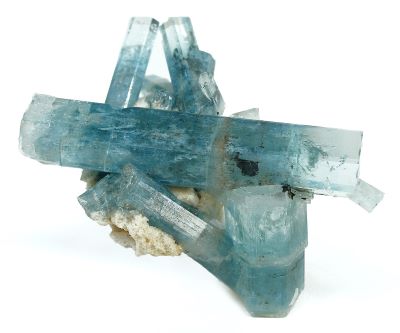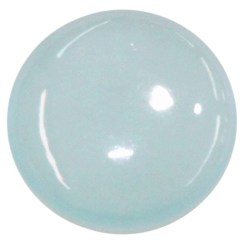Aquamarine Origin & Properties
For those who love blue gems, Aquamarine is a perennial favorite. After all, its color reminds you of the sea or the sky above us on a cloudless day. But, what’s so special about Aquamarine besides its color? What have gemologists (and jewelers) learned about this fabulous gem?
TABLE OF CONTENTS
Chemical Make-up
Aquamarine is a lovely blue gemstone and a member of the beryl family. This family includes emerald, as well as a few lesser-known varieties. Chemically, it is a beryllium aluminum silicate mineral, with a Mohs hardness of between 7.5 and 8.
Crystals tend to be hexagonal, with either a flat top or pointed like a prism. Raw Aquamarine crystals can be very large. Due to its crystal structure, Aquamarine stone tends to be brittle. Those born in March have an Aquamarine birthstone. Because Aquamarine is a hard mineral, jewelry of this specific gem is known to be durable, and can withstand regular wear.
Formation
Like most minerals, Aquamarine forms deep inside the earth. Unlike some minerals, this precious gem forms in a variety of rock, including both igneous and metamorphic rock. As a source of beryllium, the mineral beryl is fairly rare. That's because beryllium, is a rare element in and of itself, and therefore beryl can only form where there are large amounts of it.

Why is Aquamarine, Blue?
Aquamarine is blue by definition, with the color ranging from the lightest pastel blue to the signature “Aquamarine” color that has the tiniest bit of green in it, to something a bit darker. Since blue color is a defining property of Aquamarine, it doesn't come in any other color. Gemologists have determined that the blue color is a result of iron in the crystal, with the shade of blue being determined by the way in which the iron was incorporated.
Aquamarine Origin
Although it's named for the color of the sea (Aquamarine means water blue), Aquamarine was first discovered in modernity far from the sea in Siberia. The year was 1723, and by the end of the 18th century, large deposits were being mined and sent to Western Europe.
Natural Aquamarine Deposits
Today, the main deposits are in Pakistan (high in the mountains) and Brazil. Other locations include the Ural mountains in Russia, as well as China, California, and Colorado in the US, Myanmar, Ukraine, and Africa. Most of the mining is either done by picking through surface deposits, or by strip mining.
Aquamarine isn't found in deep enough deposits to warrant shaft mining. Early on, most of these light blue gems were found on the ground or in rivers, and this was especially true in Russia. Pakistani miners scale cliffs in the mountains and Brazilians sometimes use strip mining.
Aquamarine Valuation
Unlike emeralds, Aquamarine is a fairly affordable gem. Largely, this is due to the fact that it is much more abundant, and large crystals are common. According to the GIA, Aquamarine is a gemstone that doesn't have as many inclusions as emerald, so a large eye-clean Aquamarine gem is easy to obtain.
For this reason, there isn't a large premium on large carat-weight Aquamarine. Prices go up linearly by the size of the gem, assuming other quality factors are the same. As a result, this is a relatively affordable gem for gorgeous Aquamarine jewelry.
Clarity
One of the great things about cutting this light blue gem rough is that it tends to have a high clarity rating, to begin with. The GIA calls this a “type I” gemstone, meaning that many specimens are very clean when mined. However, there are plenty of rough Aquamarine pieces with inclusions. These are very inexpensive and used in creative carvings or jewelry.
Cut
When rough Aquamarine is cut, it's an opportunity to create something really beautiful. Options include faceted gems, which are the most familiar option for most aquamarine jewelry consumers. This option is usually selected for raw Aquamarine that's already close to transparent.
However, lower quality material is also made into cabochons (domed polished pieces) or carved. Some cuts are more expensive than others due to the technical difficulty of producing them. They might also cost more because they waste more of the original Aquamarine.

Color
By far, color is the most important factor in Aquamarine value. When mined, most Aquamarine has a slightly green cast. However, more valuable material is pure blue. Because Aquamarine is a light-colored gem, the most desirable pieces are larger than two carats. This allows the pure blue to come through in the stone.
In order to bring you the perfect Aquamarine white gold ring, we source heat treated gemstones (except white diamonds). Most of these light blue gems contain slight green cast when mined, so heat treating is a totally natural and permanent way to improve the color and clarity of the rough. Whether you're looking for an Aquamarine wedding ring or something that's a bit more informal, we'll be happy to help you pick the right one.
Contact us by phone at 1(844)-234-6463 or email at service@withclarity.com. Our Live Chat is available during business hours Monday - Friday 10AM - 6PM ET.
FAQs
How is Aquamarine formed?
Why is aquamarine blue?
Where was Aquamarine first discovered?
Where is Aquamarine mined?
Is Aquamarine affordable?









